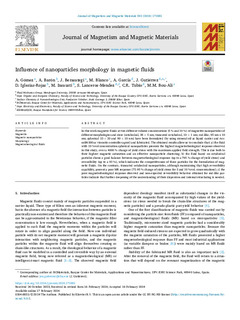| dc.rights.license | Attribution-NonCommercial-NoDerivatives 4.0 International | * |
| dc.contributor.author | Gómez, Ainara | |
| dc.contributor.author | Berasategi Arostegi, Joanes | |
| dc.contributor.author | Bou-Ali, M. Mounir | |
| dc.contributor.other | Barón, A. | |
| dc.contributor.other | Blanco, M. | |
| dc.contributor.other | García, A. | |
| dc.contributor.other | Gutierrez, J. | |
| dc.contributor.other | Iglesias-Rojas, D. | |
| dc.contributor.other | Insausti, M. | |
| dc.contributor.other | Lanceros-Mendez, S. | |
| dc.contributor.other | Tubio, C.R. | |
| dc.date.accessioned | 2024-04-10T08:12:36Z | |
| dc.date.available | 2024-04-10T08:12:36Z | |
| dc.date.issued | 2024 | |
| dc.identifier.issn | 0304-8853 | en |
| dc.identifier.other | https://katalogoa.mondragon.edu/janium-bin/janium_login_opac.pl?find&ficha_no=175903 | en |
| dc.identifier.uri | https://hdl.handle.net/20.500.11984/6335 | |
| dc.description.abstract | In this work magnetic fluids at two different volume concentrations (5 % and 10 %) of magnetite nanoparticles of different morphologies and sizes (octahedral, 38 ± 5 nm; truncated octahedral, 10 ± 1 nm; rod-like, 95 nm x 10 nm; spherical 33 ± 20 and 90 ± 10 nm) have been formulated (by using mineral oil as liquid carrier and Aerosil®300 as viscosity-controller agent) and fabricated. The obtained results allow us to conclude that: a) the fluid with 10 %vol concentration spherical nanoparticles presents the highest magnetorheological response observed in this study, over a 4000 % change of yield stress with the maximum applied field strength. This is due both to their highest magnetic saturation and an effective nanoparticle clustering; b) the fluid based on octahedral particles shows a good balance between magnetorheological response (up to a 795 % change of yield stress) and reversibility (up to a 92 %), which indicates the competitiveness of these particles for the formulation of magnetic fluids. On the contrary, truncated octahedral nanoparticles, although maintaining that high reversibility capability, present a poor MR response (75–95 % change of yield stress for 5 and 10 %vol. concentrations); c) the poor magnetorheological response observed and non-expected reversibility behavior obtained for rod-like particles indicate that further deepening of the understanding of their dispersion and internal structuring is needed. | en |
| dc.language.iso | eng | en |
| dc.publisher | Elsevier | en |
| dc.rights | © 2024 The Authors | en |
| dc.rights.uri | http://creativecommons.org/licenses/by-nc-nd/4.0/ | * |
| dc.subject | Magnetite | en |
| dc.subject | Magnetic nanoparticles | en |
| dc.subject | Morphology | en |
| dc.subject | magnetorheological fluids | en |
| dc.title | Influence of nanoparticles morphology in magnetic fluids | en |
| dc.type | http://purl.org/coar/resource_type/c_6501 | |
| dcterms.accessRights | http://purl.org/coar/access_right/c_abf2 | en |
| dcterms.source | Journal of Magnetism and Magnetic Materials | en |
| local.contributor.group | Mecánica de fluidos | es |
| local.description.peerreviewed | true | en |
| local.identifier.doi | https://doi.org/10.1016/j.jmmm.2024.171881 | en |
| local.contributor.otherinstitution | https://ror.org/000xsnr85 | en |
| local.contributor.otherinstitution | https://ror.org/01cc3fy72 | en |
| local.contributor.otherinstitution | https://ror.org/033vryh36 | en |
| local.contributor.otherinstitution | https://ror.org/005hdgp31 | |
| local.source.details | Vol. 593. N. art. 171881 | |
| oaire.format.mimetype | application/pdf | en |
| oaire.file | $DSPACE\assetstore | en |
| oaire.resourceType | http://purl.org/coar/resource_type/c_6501 | en |
| oaire.version | http://purl.org/coar/version/c_970fb48d4fbd8a85 | en |








